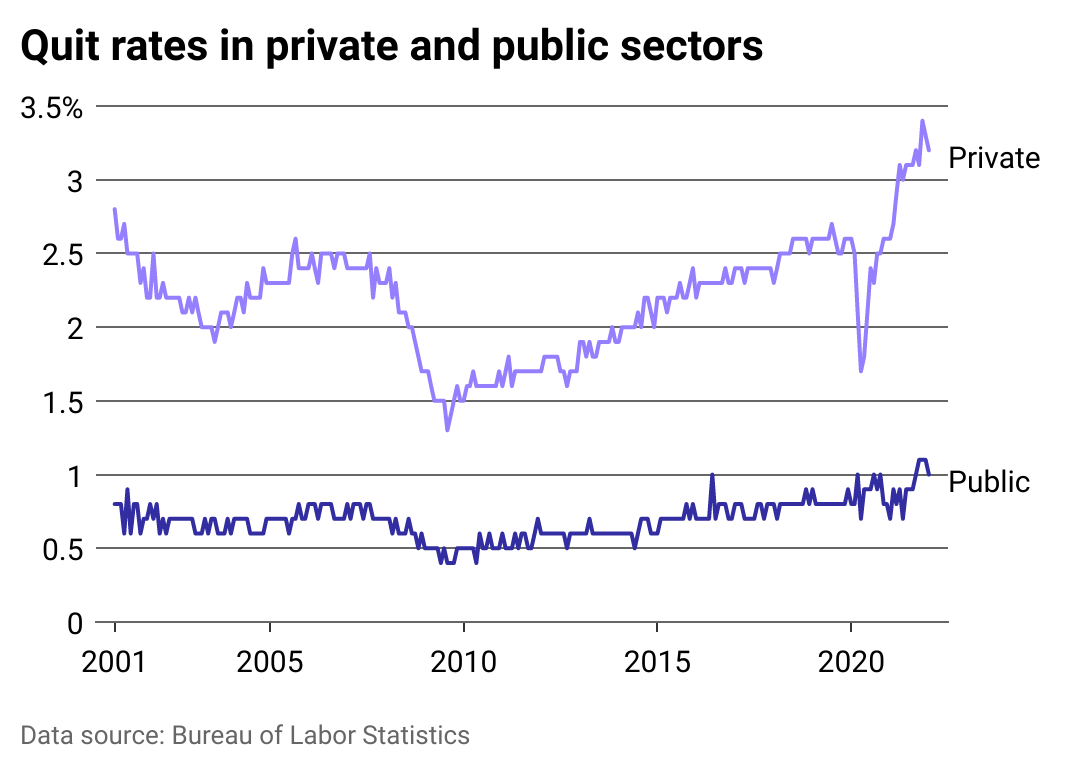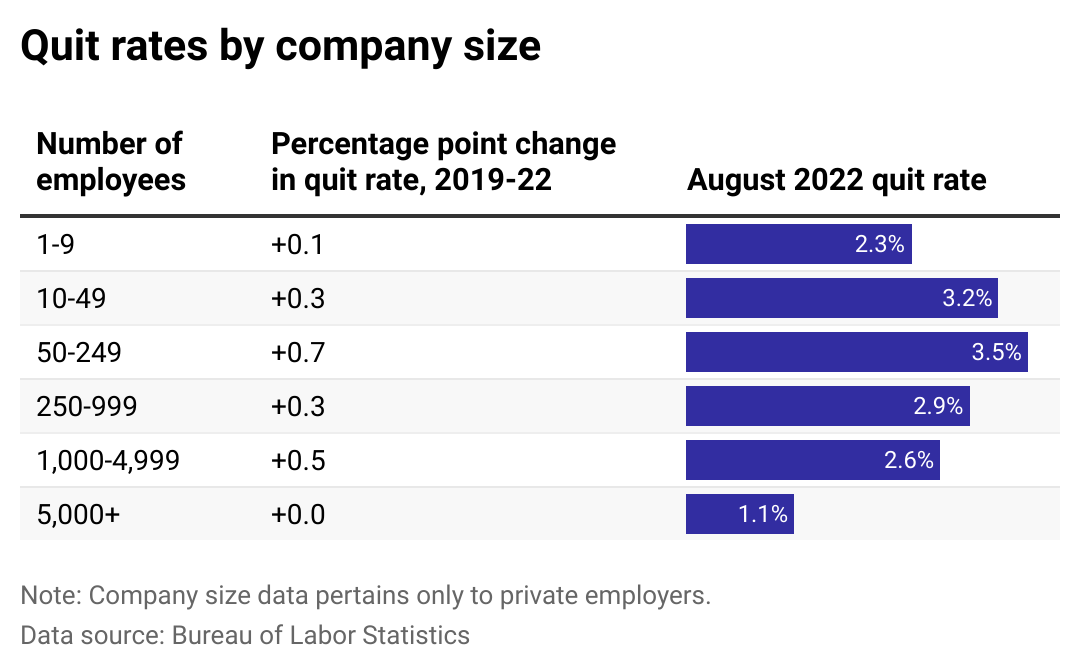How quit rates vary by company size

Andrey_Popov // Shutterstock
How quit rates vary by company size
A businessperson leaving the office through a door marked with an exit sign.
Nearly 3.5% of private-sector workers quit their jobs in November 2021, marking a record high point for the “Great Resignation” trend. But workers’ increased tendency to quit has not affected companies of all sizes equally.
Sana analyzed differences in quit rates among various organizations, and found the largest companies in the private sector had the lowest quit rates, sometimes below even those in the public sector. While reasons for quitting vary, the data show a higher percentage of public sector employees sticking around, while a higher percentage of private sector employees cut ties and sought new opportunities elsewhere. The analysis used Job Openings and Labor Turnover Survey data from the Bureau of Labor Statistics as of August 2022, the most recent nonpreliminary data available.
COVID-19-related instability led to a massive spike in unemployment in early 2020, potentially encouraging job seekers to prioritize security at work. That shift may have contributed to what the analysis found: a higher quit rate among small private companies, which some perceive as less stable, and a lower quit rate among workplaces viewed as more stable, such as large companies and government employers.
![]()

Sana
Private sector quit rates are higher and more volatile compared to the public sector
Line chart showing private and public sector quit rates, with public sector quit rates remaining low and relatively consistent, while private sector quit rates are higher and fluctuate more.
The Great Resignation affected private and public employers, though the effect was more pronounced in the private sector. In August 2022, 3% of non-government employees quit their jobs, while just 1% of government workers did so.
Quit rates among private sector employees have long been well above those for government workers for more than 20 years. This also translates into worker longevity: BLS data shows the average government worker has been in their job for 6.8 years, as compared to 3.7 years for private sector employees.
Another factor in the quit rate difference could be age: About 60% of private sector workers in the U.S. are over 35 years old, while about 75% of public sector workers in the U.S. are over 35. Older workers are more likely to stay at their jobs: BLS reports that the typical employee between the ages of 25 and 35 has been at their job for 2.8 years, while the average for workers of all ages is nearly five years.

Sana
The largest companies have the lowest quit rates
Bar chart showing the August 2022 quit rates among companies of different sizes and the percentage point change in quit rate since August 2019.
BLS data shows that enterprises with more than 5,000 employees had a quit rate of 1.1%, less than half that of any other size of company. Large companies employ just over one-third of all U.S. workers, and they’re found in all types of industries across the economy.
The next-smallest quit rate, at 2.3%, is actually for the tiniest companies, those with between 1 and 9 employees. Many of them are likely to have a very small staff—even just one or two people—who are partners in the operation. For them, quitting could mean closing the business rather than walking out the door of a business that would continue after their departure.
Companies with between 1,000 and 4,999 employees are next, with 2.6% of employees quitting in August 2022, followed by firms with 250 to 999 workers, at 2.9%.
Smaller companies—but those large enough not to be staffed only by key partners—had higher rates. Those with 10 to 49 employees saw 3.2% of workers leave in August 2022. And the next-largest companies, with 50 to 249 workers, had the highest rate, at 3.6%.
Perhaps the key factor is sensitivity to risk. Large companies tend to attract risk-averse people who may be less interested in changing jobs in a time of economic uncertainty. And large companies may be better prepared to weather financial troubles. By contrast, more risk-tolerant people tend to work at smaller companies, where they may also know the owner and have a really solid view of how the business is really going.
In the August 2022 data, quit rates do seem to be returning to pre-pandemic levels. That could be a sign the Great Resignation is slowing down. But other factors may be at play, too: The Federal Reserve Bank of St. Louis says that quit rates decrease as threats of recession increase, meaning people could be staying put out of concerns that a recession is coming to the U.S. economy.
This story originally appeared on Sana and was produced and
distributed in partnership with Stacker Studio.